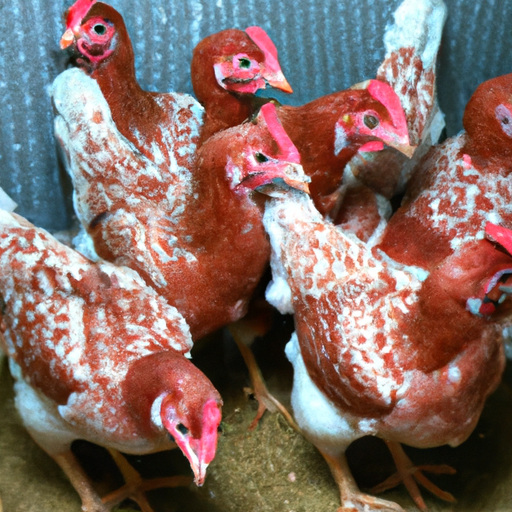
Have you ever wondered about the effects of overcrowding on the health and productivity of chickens? With the demand for poultry products on the rise, the issue of crowding within chicken farms has become increasingly prevalent. In this article, we will explore the potential consequences of overcrowding on the well-being of chickens and the overall productivity of the farming industry. By understanding these impacts, we can better appreciate the importance of providing chickens with adequate space to thrive and achieve optimal health.
Health Risks for Overcrowded Chickens
When chickens are overcrowded, they become more susceptible to various diseases. The close proximity and lack of personal space make it easier for pathogens to spread and infect the birds. Additionally, the stress from overcrowding weakens their immune system, making them more prone to infections. These diseases can range from respiratory issues, such as infectious bronchitis, to gastrointestinal problems like coccidiosis. Overcrowding also leads to higher mortality rates among the chickens, as the transmission and severity of diseases increase.
Nutritional Challenges
Overcrowded chickens often face inadequate access to feed due to competition from other birds. When a limited amount of feed is available, the chickens may exhibit aggressive behavior as they fight for their share. This competitive feeding behavior not only increases stress levels but also hinders their ability to consume enough nutrients. Furthermore, overcrowded chickens may have reduced nutrient absorption as the overcrowded conditions can negatively impact their digestive system. This can result in nutrient deficiencies, affecting the overall health and productivity of the birds.
Impact on Egg Production
Overcrowding has a significant impact on egg production in chickens. The stress caused by overcrowded conditions can lead to decreased egg quality, including thin or soft shells and irregular shapes. The size and weight of the eggs may also be reduced, resulting in lower market value. Additionally, overcrowding can impede the laying process and result in lower production rates. As the birds experience higher stress levels and face nutritional challenges, their reproductive capabilities are compromised, ultimately affecting egg production.
Behavioral Problems
The stress of overcrowding can manifest in chickens through various behavioral problems. One common issue is aggressive behavior, where overcrowded birds become more territorial and engage in aggressive acts towards others. This aggression can escalate to cannibalism and pecking, causing significant harm to the birds. Feather pecking and self-mutilation are also common behavioral problems observed in overcrowded flocks. The restricted movement and lack of space contribute to frustration, leading to these stress-induced behaviors. Additionally, overcrowding can result in physical deformities due to the limited space for proper growth and development.
Environmental Concerns
Overcrowding in chicken housing can have detrimental environmental impacts. The high number of birds concentrated in a small space leads to increased ammonia levels from their waste. Ammonia can irritate the respiratory system and cause respiratory issues in chickens. The poor air quality resulting from overcrowding and inadequate ventilation further exacerbates this problem. The accumulation of moisture due to overcrowded conditions creates a breeding ground for bacteria and fungi, increasing the risk of moisture-related problems like footpad dermatitis and hock burns. These environmental concerns, combined with the stressful conditions, contribute to elevated stress levels in the birds.
Economic Consequences
The overcrowding of chickens can have significant economic consequences for poultry farmers. As the health and productivity of the birds decline, profit margins decrease. Lower egg production rates, decreased egg quality, and reduced size and weight of the eggs all impact the revenue potential of the flock. Additionally, the loss of productivity and efficiency due to increased mortality rates and behavioral issues further affects profitability. The need for healthcare and medication to manage the health problems arising from overcrowding also adds to the production costs and reduces overall profitability.
Management Strategies
To mitigate the negative effects of overcrowding on chicken health and productivity, implementing appropriate management strategies is crucial. Proper stocking density is essential to ensure that chickens have enough space to move and exhibit normal behaviors. Adequate space and ventilation are necessary to maintain good air quality and minimize ammonia levels. Providing access to clean water and feed is vital to meet the nutritional needs of the birds. Appropriate lighting and temperature control further contribute to a conducive environment for the chickens.
Disease Prevention and Biosecurity Measures
Effective disease prevention and biosecurity measures are crucial in combating the health risks associated with overcrowding. Strict sanitation practices, including regular cleaning and disinfection of the chicken housing, help minimize the presence of pathogens. Implementing quarantine protocols for new additions to the flock reduces the risk of introducing diseases. Vaccination programs tailored to the specific diseases prevalent in the area can provide added protection to the chickens. Regular monitoring and early detection of any potential health issues allow for timely intervention and prevention of disease outbreaks.
Optimizing Nutrition and Feed Management
To address the nutritional challenges posed by overcrowding, optimizing nutrition and feed management is essential. Formulating a balanced diet that meets the specific nutritional requirements of the chickens is crucial for their overall health and productivity. Proper feed allocation and distribution techniques can ensure that all birds have equal access to feed and minimize competition. Supplementation with vitamins and minerals may be necessary to address any nutrient deficiencies and optimize the birds’ health.
Addressing Behavioral Issues
To tackle the behavioral problems arising from overcrowding, providing environmental enrichment is crucial. Enriching the chicken housing with perches, dust baths, and objects that stimulate natural behaviors can alleviate frustration and reduce aggressive tendencies. Implementing effective management techniques to manage aggression and pecking, such as providing adequate space and ensuring a balanced social structure, is important. In some cases, beak trimming and beak modification may be necessary to prevent cannibalism and pecking among overcrowded chickens.
In conclusion, overcrowding in chicken housing poses several health risks and challenges that affect the well-being and productivity of the birds. Increased susceptibility to diseases, spread of infectious diseases, higher mortality rates, stress-related health issues, inadequate access to feed, competitive feeding behavior, reduced nutrient absorption, decreased egg quality, reduced egg size and weight, lower egg production rates, aggressive behavior, cannibalism and pecking, feather pecking and self-mutilation, restrictive movement and physical deformities, increased ammonia levels, poor air quality, higher risk of moisture-related problems, elevated stress levels, decreased profit margins, loss of productivity and efficiency, and higher healthcare and medication costs are all consequences of overcrowding. By implementing appropriate management strategies, disease prevention and biosecurity measures, optimizing nutrition and feed management, and addressing behavioral issues, poultry farmers can mitigate these negative impacts and promote the health and productivity of their chickens.







